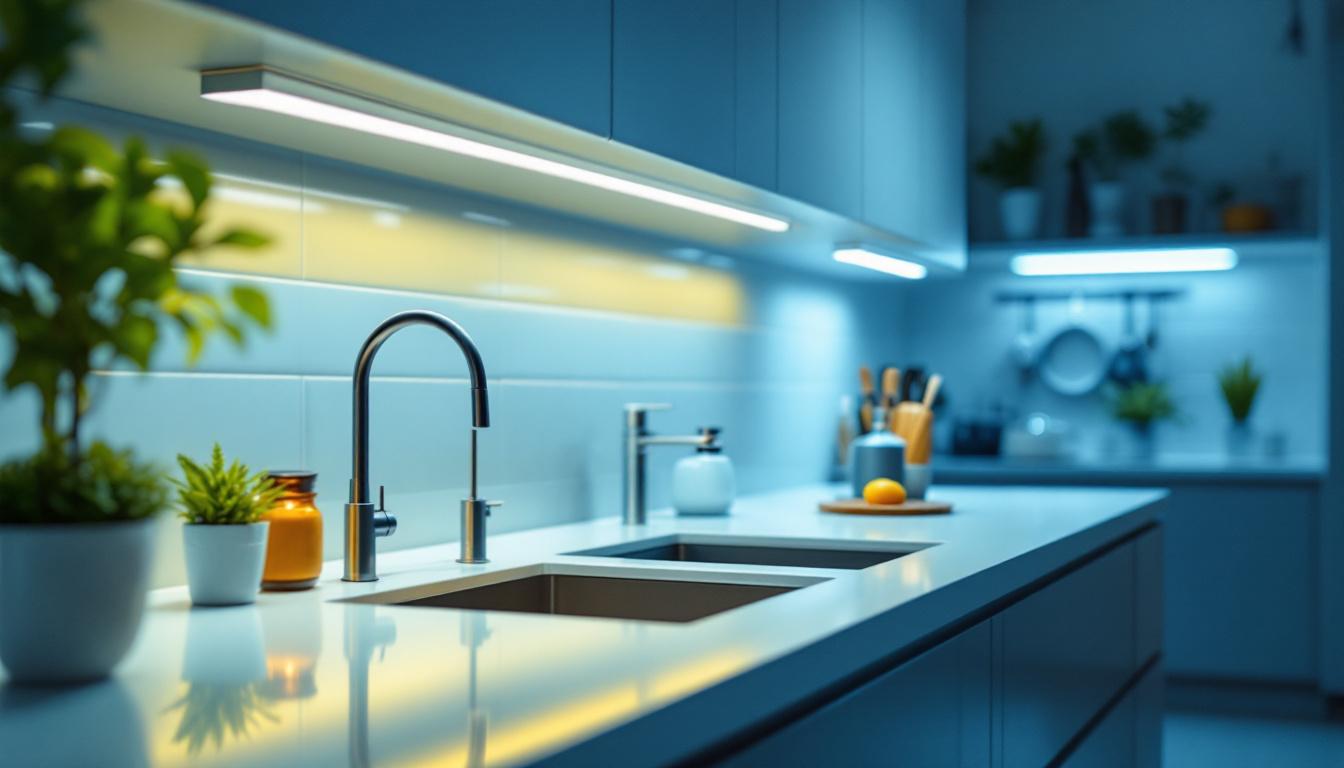
In the ever-evolving world of lighting solutions, LED high bay lighting has emerged as a preferred choice for various commercial and industrial applications. As lighting contractors, understanding the tools and technologies that facilitate the installation and maintenance of these systems is crucial. This article delves into the essential tools that can enhance the efficiency and quality of LED high bay lighting projects.
LED high bay lights are specifically designed to illuminate large spaces with high ceilings, such as warehouses, manufacturing facilities, and gymnasiums. They provide bright, focused light that enhances visibility and safety in these expansive areas. The transition to LED technology not only improves energy efficiency but also reduces maintenance costs due to the long lifespan of LED bulbs.
For lighting contractors, it is essential to grasp the technical specifications and benefits of LED high bay lighting. This knowledge enables them to recommend the best solutions to their clients and ensures that installations meet industry standards and customer expectations. Understanding factors such as lumen output, color temperature, and beam angle can help contractors tailor their recommendations to the specific needs of each space, ensuring optimal performance and satisfaction.
One of the primary advantages of LED high bay lighting is its energy efficiency. Compared to traditional lighting solutions like metal halide or fluorescent lights, LEDs consume significantly less power, resulting in lower electricity bills. This aspect is particularly appealing to businesses looking to reduce operational costs. Moreover, many utility companies offer rebates and incentives for switching to energy-efficient lighting, further enhancing the financial benefits of LED installations.
Additionally, LED lights have a longer lifespan, often exceeding 50,000 hours. This longevity translates to fewer replacements and less frequent maintenance, which is a significant benefit for contractors and clients alike. Furthermore, LED technology offers instant illumination and minimal warm-up time, ensuring that spaces are lit promptly when needed. Beyond these practical advantages, LED high bay lights also come in a variety of designs and styles, allowing for greater flexibility in aesthetics and functionality. Some models even include smart technology features, such as dimming capabilities and motion sensors, which can further enhance energy savings and adapt lighting to the specific activities taking place in the space.
Equipping oneself with the right tools is vital for any lighting contractor. When it comes to installing LED high bay lighting, several key tools can streamline the process and enhance safety.
Given that high bay lights are typically installed at considerable heights, sturdy ladders and lifting equipment are indispensable. A reliable extension ladder allows for safe access to elevated areas, while scissor lifts or boom lifts can facilitate the installation of fixtures in large spaces. Selecting the right type of equipment based on the project’s specific requirements is crucial for ensuring safety and efficiency. Additionally, it’s important to regularly inspect these tools for wear and tear, as any malfunction could lead to serious accidents during installation.
Furthermore, using harnesses and safety gear in conjunction with ladders and lifts can significantly reduce the risk of falls. Safety harnesses should be worn when working at heights, especially in environments where the risk of slipping is high. Investing in high-quality safety equipment not only protects the contractor but also instills confidence in clients regarding the professionalism and safety standards of the installation process.
Electrical tools are fundamental to any lighting installation project. Essential items include wire strippers, screwdrivers, and multimeters. Wire strippers are necessary for preparing electrical cables, while screwdrivers help secure fixtures in place. A multimeter is vital for measuring voltage, current, and resistance, ensuring that all electrical connections are functioning correctly.
Moreover, having a quality drill on hand is essential for mounting fixtures securely. A cordless drill can enhance mobility and convenience, allowing contractors to work efficiently without being tethered to a power source. In addition, a set of drill bits specifically designed for metal and wood can be beneficial, as different materials may require different approaches for effective installation. Keeping a well-organized toolbox with all necessary tools readily available not only saves time but also minimizes the risk of losing essential items during a project.
To further enhance the installation process, contractors should consider investing in a laser level. This tool ensures that fixtures are installed at the correct height and alignment, which is particularly important in large industrial settings where precision is key. Using a laser level can significantly reduce the time spent on adjustments and rework, allowing for a smoother installation experience overall.
Safety should always be a top priority for lighting contractors. Working at heights and with electrical systems presents inherent risks, making proper safety equipment essential.
Personal protective equipment, or PPE, includes hard hats, safety goggles, gloves, and high-visibility vests. Hard hats protect against falling objects, while safety goggles shield the eyes from debris and electrical hazards. Gloves provide grip and protection from sharp edges, and high-visibility vests ensure that contractors are seen in busy work environments. Additionally, contractors should consider wearing hearing protection, especially in environments with high noise levels from machinery and tools. Hearing loss can be gradual and irreversible, making it vital to safeguard auditory health with earplugs or earmuffs. Furthermore, steel-toed boots are essential for foot protection, providing a sturdy barrier against heavy equipment and potential punctures from sharp objects on the ground.
When working at heights, fall protection gear is crucial. Harnesses, lanyards, and safety nets are essential components of a fall protection system. These tools help prevent accidents and ensure that contractors can work safely without the risk of serious injury. Familiarity with local safety regulations and guidelines is also important for compliance and worker safety. In addition to traditional harnesses, contractors should explore the use of self-retracting lifelines, which allow for greater mobility while still providing fall protection. These devices automatically lock in place during a fall, minimizing the distance a worker could fall and reducing the risk of injury. Training in proper use and inspection of all fall protection equipment is equally important, as even the best gear can fail if not used correctly or maintained properly. Regular safety drills and refreshers can help ensure that all team members are prepared and knowledgeable about fall protection protocols, fostering a culture of safety on the job site.
Once LED high bay lighting systems are installed, regular maintenance is necessary to ensure optimal performance. Having the right tools for troubleshooting and maintenance can save time and enhance service quality.
Inspection tools, such as infrared thermometers and light meters, are invaluable for assessing the performance of LED lighting systems. Infrared thermometers can detect overheating components, while light meters measure the intensity of illumination in various areas. These tools help contractors identify issues before they escalate, ensuring that clients receive consistent and reliable lighting.
Keeping a stock of replacement parts and accessories is essential for quick maintenance and repairs. This includes spare bulbs, drivers, and mounting hardware. Having these components readily available allows contractors to address issues promptly, minimizing downtime for clients and maintaining customer satisfaction.
As technology continues to advance, lighting contractors can benefit from incorporating advanced tools into their workflow. These tools can enhance efficiency and improve the quality of installations.
Smart lighting controls enable contractors to offer clients advanced features such as dimming, scheduling, and remote management. These systems can be integrated with building management systems (BMS) for enhanced energy efficiency and convenience. Familiarity with smart lighting technology can set contractors apart in a competitive market, providing clients with modern solutions that meet their evolving needs.
Utilizing 3D design software can significantly improve the planning and visualization of lighting projects. This software allows contractors to create detailed layouts and simulations, helping clients visualize the final outcome before installation begins. By presenting a clear and accurate representation of the project, contractors can enhance client confidence and streamline the decision-making process.
In addition to having the right tools, following best practices during installation and maintenance can lead to successful outcomes. These practices ensure that lighting systems operate efficiently and meet client expectations.
Before beginning any installation, conducting a thorough site assessment is essential. This assessment should include evaluating the existing electrical infrastructure, measuring ceiling heights, and identifying any potential obstacles. Understanding the specific requirements of the space allows contractors to select the appropriate fixtures and installation methods.
Proper placement of LED high bay fixtures is crucial for achieving optimal illumination. Contractors should consider factors such as the layout of the space, the height of the ceilings, and the intended use of the area. Utilizing lighting design software can assist in determining the best placement for fixtures to ensure even light distribution and minimize shadows.
LED high bay lighting has transformed the way large spaces are illuminated, offering energy efficiency, longevity, and enhanced visibility. For lighting contractors, understanding the essential tools and best practices for installation and maintenance is vital for success in this competitive field. By equipping themselves with the right tools, prioritizing safety, and staying informed about technological advancements, contractors can deliver high-quality lighting solutions that meet the needs of their clients.
As the demand for energy-efficient lighting continues to grow, the role of lighting contractors becomes increasingly important. By investing in the right tools and knowledge, contractors can position themselves as leaders in the industry, providing exceptional service and innovative solutions that stand the test of time.
Ready to elevate your lighting projects with the efficiency and quality of LED high bay lighting? Look no further than LumenWholesale for all your lighting needs. We provide contractors with top-notch, spec-grade lighting products at prices that can’t be beaten. Say goodbye to the middleman and hello to superior lighting products at wholesale rates. Our extensive selection is designed to meet the highest industry standards, ensuring you deliver reliable and high-performance lighting solutions every time. Plus, with free shipping on bulk orders, you can stock up on premium lighting without worrying about hidden fees or compromises. Make the smart choice for your business and visit LumenWholesale today for Wholesale Lighting at the Best Value.

Discover the essential insights lighting contractors need to know about LED undercounter lights.

Discover how solar powered pole lamps are revolutionizing the lighting industry with sustainable technology, cost efficiency, and innovative design.

Discover how lighting contractors can boost their business by integrating exterior sconce solar lighting solutions.

Illuminate your patio projects with expert tips tailored for lighting contractors.